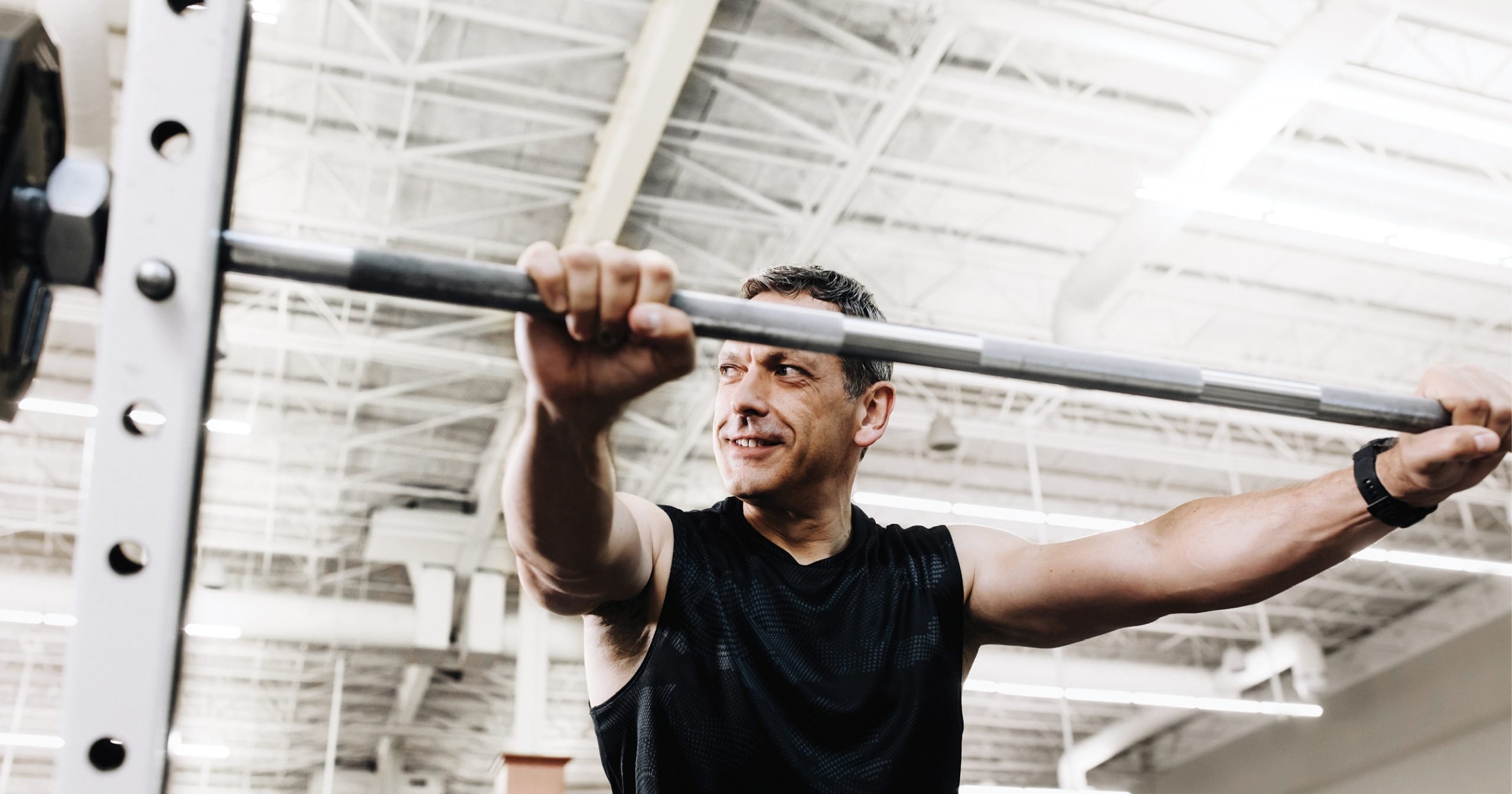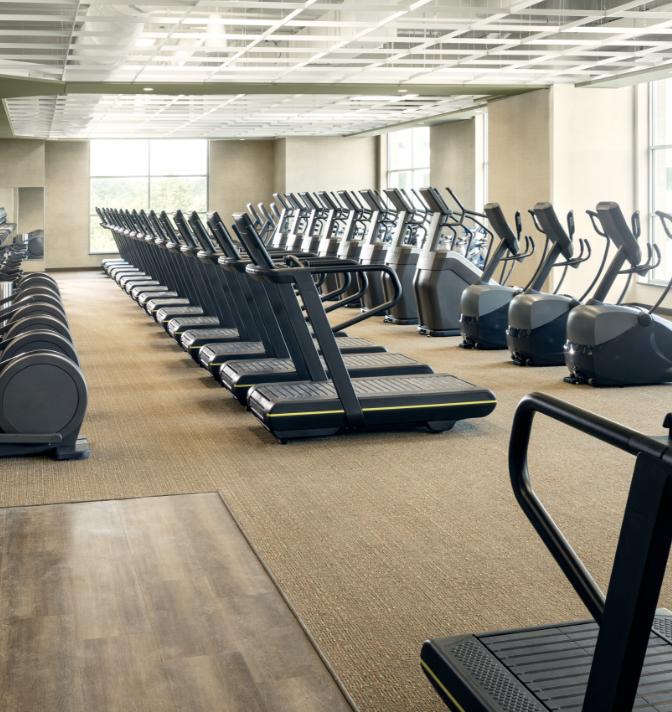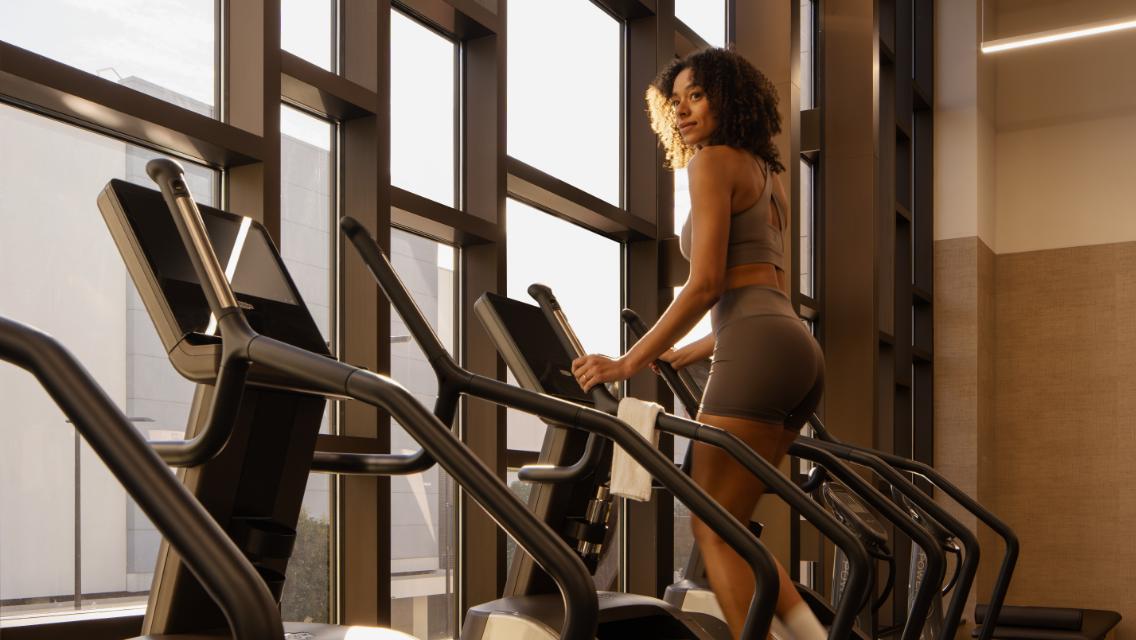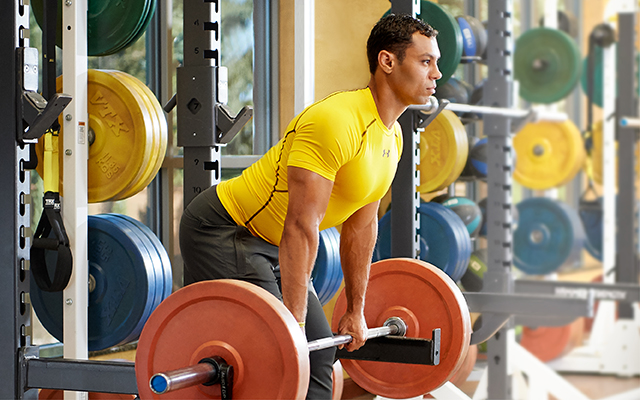At long last, it’s time to get back to your health club, fitness center, or gym. After some time away, and doing the best you could with your home-based workouts, you’re probably eager to rebuild your strength and muscle, shed any body fat you might have built up while being at home, and do everything you can to protect yourself from COVID-19 and any other pathogen your immune system might encounter.
Our 12-Week Comeback Workout Program is designed to help you get you back in tip-top shape — quickly and safely.
Overview: Rebuilding Strength After Sheltering in Place
Though there are numerous questions surrounding SARS-CoV-2 and how it affects us, we know a few things about the virus, its effect on our health, and our ability to control how our bodies respond to it:
- Healthy people tend to have mild symptoms when they’re exposed to SARS-CoV-2; many are asymptomatic and never show symptoms of the condition.
- Those with pre-existing conditions or those over the age of 60 are at the greatest risk of severe conditions. We cannot do anything about our age, but we can absolutely reduce the occurrence of obesity, type 2 diabetes, and hypertension through good lifestyle, exercise, and nutrition choices (all of which we talk about here). That said, it’s imperative for those with pre-existing conditions to carefully follow CDC guidelines, and when necessary, continue to shelter in place.
- It’s likely you will be exposed to SARS-CoV-2, if you haven’t been already. The best thing we can do to protect ourselves from COVID-19 or other pathogenic diseases (in addition to following CDC guidelines) is to remain healthy and support a strong immune system.
This 12-week program is designed to get you back into routine after your quarantine, while supporting a strong immune system in the event you get infected with SARS-CoV-2. You might even end up in better shape than you were before the national shutdown.
This guide includes three main sections: Nutrition, Lifestyle, and Exercise.
Each four-week block of your training plan has a specific purpose, so avoid the temptation to jump ahead. If the workouts seem too easy, use more weight. This is designed as a progressive plan to help you get back into shape without increasing your risk of getting injured or sick.
The nutrition plan is made of two six-week phases: The first phase sets the foundation for the second phase.
Bookmark this page so you can keep coming back to reference it as you progress through the program.
Is it easier or harder to rebuild muscle and strength after losing it?
It’s much easier to regain what you’ve lost than it is to build it in the first place.
First, you’ve already trained your nervous system to perform an exercise correctly. Developing that muscle memory and coordination the first time took much longer, which slowed your strength gains.
When you get back on the fitness floor, you won’t need weeks to relearn movements, just like it doesn’t take any time to relearn how to ride a two-wheeled bike the first time you get back on after the winter.
Second, you don’t lose your muscle-making machinery when you lose muscle size and strength.
Part of the process of muscle growth involves creating additional nuclei for your muscle cells. The nucleus of your muscle cell contains the genetic material of muscle growth.
When you lose muscle, you lose overall muscle mass, but research shows you do not lose nuclei. With a greater number of muscle nuclei (also known as myonuclei) you have more genetic material, or DNA, to build muscle mass with.
Two nuclei, when stimulated by strength training, build muscle faster than one.
Since you already have more of the machinery for making muscle, you’ll regain muscle faster than you did the first time around.
Nutrition
The best training plan is of little value without a good nutrition plan to complement it. Everyone will experience some level of stress as they transition from their “shelter in place” routine to their normal weekly routine. We’re focusing on the most essential aspects of nutrition for your first six weeks.
Nutrition Weeks 1–6
For your first six weeks, keep it simple. Even if you’re already doing what’s outlined here, continuing to do it with a new schedule can create unexpected hiccups. If you adhere to these habits, you’ll get more out of your diet in the next six weeks.
- Eat a high-protein diet. Eat protein with each meal and at least one gram of protein per pound of ideal body weight per day. High-protein diet health benefits include enhanced recovery, support for your immune system, healthier blood-sugar levels, and improved body composition. Higher-protein intakes also enhance satiety, so you eat less of the foods you shouldn’t eat. Feel free to use whey protein, collagen protein, and/or vegan protein to increase your daily protein intake.
- Limit carbs with breakfast and lunch, and eat a variety of nonstarchy vegetables with each meal. The lower carb intake will help you keep your blood sugar, insulin, and body fat in check. The nonstarchy vegetables add fiber, as well as a variety of micronutrients and phytonutrients.
- Do not restrict calories. Now is not the time to get on a restrictive diet. Calorie-restriction is a stressor and has the potential to reduce immune function. While you add back the physical stress of exercise, and the mental stress of reorganizing your lifestyle to transition to your old “normal,” you don’t need to add the additional stress of calorie restriction. We’ll get to that in the next phase. As my wife and I often tell our grandson, “Patience is a virtue.”
- Take the Foundational Five. It doesn’t hurt to take other supplements, just take them in addition to the Foundational Five, not instead of them. Before we recommend other “targeted” supplements, we always start with the Foundational Five:
As you might expect, we’re biased toward Life Time’s nutrition products, as we know the quality, purity, and efficacy of our formulas. You can find the Life Time Foundational Five here.
Nutrition Weeks 7–12
- Continue habits from Weeks 1–6. Eat a high-protein diet. Limit carbs with breakfast and lunch. Take your Foundational Five supplements.
- Eliminate snacks. You do not need to snack. Unless you’re a high-performance athlete training for hours each day or a physique competitor who’s within a month of a competition, there is no benefit to snacking — and much detriment. When you leave gaps between meals, your blood sugar has time to stabilize. Also growth hormone rises about three hours after eating, which supports fat metabolism and muscle recovery.
- Eliminate gluten and limit dairy. Gluten offers no health benefit whatsoever and can cause a variety of issues for many people, not just those who have a gluten allergy. Since a goal of this program is to minimize systemic inflammation, avoid all gluten-containing foods. As for dairy, limit it to whey protein, if you consume it. If your life revolves around cheese or yogurt, don’t worry: You can get back to them in the future. For now, keep them out of the diet.
- Consider adding the following supplements: Amino Acids and Curcumin Phytosome (Meriva®). If you have trouble with not snacking between meals, consider a serving or two of essential amino acids. Curcumin Phytosome, or Meriva®, supports normal inflammation and blood-sugar levels, while minimizing delayed onset muscle soreness (DOMS).
Lifestyle
- Sleep at least seven hours each night. Eight is even better. The only way your body recovers from exercise is when you provide the nutrition it needs to rebuild and repair, and get the sleep you need to support your metabolism. If you need it, try extra magnesium, Relora, or a melatonin-based supplement to calm your mind so you can get to sleep at a consistent time.
- Minimize muscle soreness. You shouldn’t experience excessive muscle soreness with this program, but if you do, keep it in check. If you’re already meeting your protein needs, try taking extra essential amino acids between meals. Research shows Curcumin Phytosome (Meriva®) reduces exercise-related muscle soreness. (Read more about how to reduce Delayed Onset Muscle Soreness here.) Also, drink more coffee: While there are many reasons coffee is good for you, one of them is that caffeine dulls pain and is one of the most proven ergogenic aids, which could make your workouts even better.
- Get outside.
- Walk for at least 20 minutes, five days per week. Walking is great for reducing stress, reducing muscle soreness, and helping you avoid the negative metabolic effects of too much sitting. This activity isn’t about how many calories you burn: It’s simply to get your body (and metabolism) moving.
Exercise
This training plan progressively increases training volume and intensity over the 12 weeks.
The first four weeks — Phase I — focus on improving overall strength and movement proficiency. You’ll follow a two-day split routine performed over three workouts per week. Though the outline below shows your training sessions on Monday, Wednesday, Friday, feel free to adjust the dates to meet your schedule or the availability at your fitness center.
For Phase I, you’ll complete three strength-training sessions and one recreational workout day.
Many fitness centers will have capacity challenges during Phase I, so this programs offers a lot of flexibility around when you do your three training sessions.
You’ll alternate push and pull days. This means that in one strength-training session, you’ll do movements like squats, chest presses and shoulder presses. In another, you’ll do things like pull-ups and rows. Fit your recreational activity day in whenever it works with your schedule.
Recommendations and Definitions for All Workouts
- Warm-Up / Prep Work: Before each workout, we recommend completing a variety of movements to engage the muscles you’ll work in the upcoming set. These could include active stretches or bodyweight movements.
- Warm-Up Sets: Complete up to three warm-up sets of your first one to two exercises, working up to your training weight. The sets recommended are “working sets,” not warm-ups.
- Reps and Weight: Once you’re able to complete all sets in a session with good form with the same weight, increase the weight the next time you perform the same movement.
- Rate of Perceived Exertion (RPE): A subjective measure of how intensely you’re training on a scale of 1 to 10. A “1” would be lying on the couch, watching television, while a “10” would be running away from a lion that escaped from the zoo.
Training Plan Weeks 1–4
| Example Schedule | Wk 1 | Wk 2 | Wk 3 | Wk 4 |
|---|---|---|---|---|
| M | TS 1 | TS 2 | TS 1 | TS 2 |
| T | ||||
| W | TS 2 | TS 1 | TS 2 | TS 1 |
| T | ||||
| F | TS 1 | TS 2 | TS 1 | TS 2 |
| S | ||||
| S | ||||
| Recreation Day: Pick at least one day to do something you enjoy, simply for the activity, not the exercise. Examples include frisbee golf, a long bike ride, pickle ball, soccer, etc. | ||||
| Training Session 1: Push Day | Sets x Repetitions |
|---|---|
| Barbell Back Squat | 4 x 5–7 |
| Dumbbell Chest Press | 4 x 5–7 |
| Barbell Reverse Lunge | 3 x 8–10 per leg |
| Dumbbell Standing Shoulder Press | 3 x 6–8 |
| Dumbbell Triceps Extension | 3 x 8–10 |
Training Session 1 Video Demos
| Training Session 2: Pull Day | Sets x Repetitions |
|---|---|
| Barbell Romanian Deadlift (RDL) | 4 x 5–7 |
| Pull-Up or Pulldown | 4 x 5–7 |
| Barbell Hip Thrust | 3 x 8–10 |
| Dumbbell 1-Arm Row | 3 x 8–10 |
| Dumbbell Alt. Curl (rotational) | 3 x 8–10 |
Training Session 2 Video Demos
Training Plan Weeks 5–8
| Example Schedule | Wk 1 | Wk 2 | Wk 3 | Wk 4 |
|---|---|---|---|---|
| M | TS 1 | TS 1 | TS 1 | TS 1 |
| T | TS 2 | TS 2 | TS 2 | TS 2 |
| W | ||||
| T | TS 3 | TS 3 | TS 3 | TS 3 |
| F | TS 4 | TS 4 | TS 4 | TS 4 |
| S | ||||
| S | ||||
| Recreation Day: Pick at least one day to do something you enjoy, simply for the activity, not the exercise. Examples include frisbee golf, a long bike ride, pickle ball, soccer, etc. | ||||
| Training Session 1: Lower Body | Sets x Repetitions |
|---|---|
| Barbell Back Squat | 4 x 8–10 |
| Fixed Barbell Walking Lunge | 3 x 8–10 per leg |
| Machine Prone Leg Curl (feet neutral) | 3 x 10–12 |
| Plate-Loaded Seated Calf Raise (feet neutral) | 4 x 20 |
| Plank | 3 x max time (with strict form) |
| Treadmill at 10% Incline | 15 minutes at 6/7 RPE |
Training Session 1 Video Demos
| Training Session 2: Upper Body | Sets x Repetitions |
|---|---|
| Pull-Up / Pulldown | 3 x 8–10 |
| Dumbbell Chest Press | 3 x 8–10 |
| Cable Row | 3 x 10–12 |
| Barbell Incline Bench Press | 3 x 10–12 |
| Dumbbell Standing 1-Arm Shoulder Press | 3 x 8–10 |
| Elliptical | 15 minutes at 6/7 RPE |
Training Session 2 Video Demos
| Training Session 3: Lower Body | Sets x Repetitions |
|---|---|
| Barbell Reverse Lunge | 3 x 8–10 per leg |
| Dumbbell Romanian Deadlift (RDL) | 3 x 8–10 |
| Barbell Hip Thrust | 3 x 10–12 |
| Superset | |
| Machine Leg Extension | 3 x 10–12 |
| Machine Seated Leg Curl | 3 x 10–12 |
| Machine Standing Calf Raise | 3 x 20 |
| Treadmill at 10% incline | 15 minutes at 6/7 RPE |
Training Session 3 Video Demos
| Training Session 4: Upper Body | Sets x Repetitions |
|---|---|
| Bent-Over Barbell Row (overhand) | 3 x 8–10 |
| Dumbbell Incline Chest Press | 3 x 8–10 |
| Cable Pulldown (close grip) | 3 x 10–12 |
| Dips – Chest Focus (assisted, bodyweight, or weighted) | 3 x 10–12 |
| Hanging Knees Raise | 3 x max |
| Elliptical | 15 minutes at 6/7 RPE |
Training Session 4 Video Demos
Training Plan Weeks 9–12
| Example Schedule | Wk 1 | Wk 2 | Wk 3 | Wk 4 |
|---|---|---|---|---|
| M | TS 1 | TS 1 | TS 1 | TS 1 |
| T | TS 2 | TS 2 | TS 2 | TS 2 |
| W | TS 3 | TS 3 | TS 3 | TS 3 |
| T | ||||
| F | TS 4 | TS 4 | TS 4 | TS 4 |
| S | TS 5 | TS 5 | TS 5 | TS 5 |
| S | ||||
| Recreation Day: Pick at least one day to do something you enjoy, simply for the activity, not the exercise. Examples include frisbee golf, a long bike ride, pickle ball, soccer, etc. | ||||
Alternating Sets: After completing your set of one exercise, rest 60 seconds and do the next exercise in the pairing. Rest 60 seconds and then do the first exercise.
Superset: Complete both exercises, one after another, without rest. Then, rest 60 seconds before beginning the first exercise again.
Compound Sets: Complete all exercises in group, one after another, without resting between exercises. Then, rest 60 seconds and do the group again.
| Training Session 1: Back / Chest | Sets x Repetitions |
|---|---|
| Alternating Sets | |
| Pull-Up (assisted, bodyweight, or weighted) | 3 x 6–8 |
| Barbell Standing Shoulder Press | 3 x 6–8 |
| Alternating Sets | |
| Dumbbell 1-Arm Row | 3 x 6-8 |
| Dumbbell Incline Chest Press | 3 x 6-8 |
| Alternating Sets | |
| Cable Straight Arm Pulldown (straight bar) | 3 x 15 |
| Dips – Chest Focus (assisted, bodyweight, or weighted) | 3 x 15 |
| Walk/Jog/Run – If on a treadmill, set incline at 3% | 1 mile for time |
Training Session 1 Video Demos
| Training Session 2: Lower Body | Sets x Repetitions |
|---|---|
| Barbell Back Squat – Rest only 30 seconds between sets | 6 x 10 |
| Plate Loaded Leg Press | 3 x 6–8 |
| Superset | |
| GHR Bench Glute Ham Raise or Lying Leg Curl | 3 x 10 |
| Fixed Barbell Walking Lunge | 2 x 16 |
| Leg Press Calf Raise | 4 x 15–20 |
Training Session 2 Video Demos
| Training Session 3: Shoulders & Arms | Sets x Repetitions |
|---|---|
| Compound Set | |
| EZ Bar Upright Row | 3 x 10 |
| Fixed Barbell Biceps Curl (narrow) | 3 x 8 |
| Barbell Close Grip Bench Press | 3 x 8 |
| Compound Set | |
| Dumbbell Front Raise | 3 x 12 |
| Dumbbell Side Raise | 3 x 12 |
| Dumbbell Alt. Hammer Curl (cross-body) | 3 x 12 |
| Dumbbell Incline Tricep Extension | 3 x 12 |
| Compound Set | |
| Dumbbell Arnold Press (standing) | 3 x 12 |
| Dumbbell Chest Supported Incline Biceps Curl | 3 x 15 |
| Cable Triceps Extension (V-bar) | 3 x 15 |
Training Session 3 Video Demos
| Training Session 4: Back / Chest | Sets x Repetitions |
|---|---|
| Superset | |
| Dumbbell Bent-Over Row | 3 x 8 |
| Dumbbell Chest Press | 3 x 8 |
| Superset | |
| Cable Pulldown (wide grip) | 3 x 10 |
| Dumbbell Standing Shoulder Press | 3 x 10 |
| Superset | |
| Cable Pulldown (neutral grip) | 3 x 12 |
| Incline Dumbbell Chest Press | 3 x 12 |
| Superset | |
| Dumbbell Standing Spider Curl | 3 x 15 |
| Cable Triceps Extension (V-bar) | 3 x 15 |
| Bear Crawl Forward | 10 yards |
Training Session 4 Video Demos
| Training Session 5: Legs / Arms | Sets x Repetitions |
|---|---|
| Superset | |
| Barbell Front Squat | 3 x 6 |
| Barbell Romanian Deadlift (RDL) | 3 x 10 |
| Superset | |
| Kettlebell Deficit Reverse Lunge (rack) | 3 x 12 |
| SAQ – Skater (Speed Skater Hops) | 3 x 12 |
| Superset | |
| Dumbbell Seated Biceps Curl | 3 x 15 |
| Cable Triceps Pushdown | 3 x 15 |
| You choose: | |
| Option 1: Sled Drag with 90 pounds. Forward drag AFAP 25 yards. Rest 30 seconds. Backward drag AFAP 25 yards. Rest 30 seconds. Forward drag AFAP 25 yards. Rest 30 seconds. Backward drag AFAP 25 yards. Rest 30 seconds. | |
| Option 2: Inclined Sprint Intervals Set treadmill at a 15% incline. Standing on sides of treadmill (not the track) turn the speed up to a running/sprinting speed that you can manage. Sprint for 20 seconds. Hop to the sides and rest 10 seconds. Repeat 10 times for a total of five minutes. |
|
Training Session 5 Video Demos





